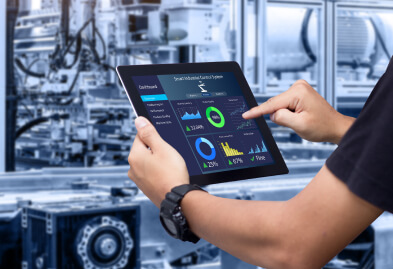
A few years back, experts noted that organizations that underwent the changes associated with the 4th Industrial Revolution would benefit from unprecedented results. Those benefits, however, have yet to be seen as most organizations have remained stagnant in their efforts to adopt technology. Most of the production industry (~70%) remains in pilot purgatory (where technology pilots last for extended periods of time, and companies do not take the final step of scaling up viable technologies). Less than 30% of manufacturing companies are actively rolling out Fourth Industrial Revolution technologies at scale.
It’s important to understand that the industrial Internet of Things (IoT) is really a subset of Industry 4.0. Just as with previous industrial revolutions, Industry 4.0 really signifies a fundamental change in the way we manufacture products. Where the third Industrial Revolution was based on computers and followed by automation; the fourth Industrial Revolution builds on that premise. With increasingly smart machine tools and robotics, coupled with advanced software systems, the need for humans in much of the manufacturing process is being eliminated.
Now, this shift isn’t a bad thing, as it will provide the ability for your employees to perform more meaningful work and give them greater opportunities. With that in mind, though, it’s important to recognize that these new manufacturing jobs will require a higher level of technical and computer skills. Now as far as the Manufacturing IoT goes, this is really just an extension of the more consumer-centric Internet of Things. The manufacturing IoT presents users with remote access capabilities, and the ability to collect, view, and analyze operational data to allow for action to be taken in real-time. For example, IoT capable machine tools use sensors to monitor their various systems, such as motors, spindles, and other electronics. This data is then made available to the appropriate people for analysis and action. If properly implemented, the results in productivity, product quality, and machine utilization are far greater than before.
Digital Transformation, or also referred to as Industrial Transformation, can take on many different forms. At the basic level, it’s taking all of the paper forms and converting them into a digital version. This can be extended to reporting. Instead of using an Excel spreadsheet, teams can now have real-time dashboards that are scattered throughout your plant. In working with manufacturing clients, we have seen just how much efficiency is lost through the shuffling and misplacement of paper.
For Manufacturers, the 4th Industrial Revolution will mean the integration of technology throughout the manufacturing process, which will result in an increase in data creation.
Next is the O.E.E., that’s your Overall Equipment Effectiveness. Through the IoT and Industrial Transformation, companies can now connect more of these devices, creating greater visibility and better metrics. Once you go through this transformation and connect these devices, instead of just having an overall view of “what’s our current availability” and “am I able to run my equipment?” you can answer more in-depth questions like “What is our available product?”, “How productive are we right now?”, and “are we building quality products?”. With Transformation and having more overall data points, you get greater and greater visibility and more granularity into your overall processes.
As mentioned previously, Digital Transformation can take shape in a number of ways due to its complexities. A possible reason for “pilot purgatory” is that achieving UI value, even in the 90th percentile, is in itself a lofty goal. In order to achieve this, manufacturers really need to remove waste wherever possible. Other investments in Digital Transformations that can be made to have a significant impact are tools like toolpath simulation software, quick-change tooling, and work holding, as well as tool presetting systems. We often hear that the majority of people believe that these are expensive systems. However, you can’t view it only as a cost because they are accompanied by a very quick ROI. Once those technologies are in place, with IoT, you’ll be able to analyze manufacturing processes and further improve on your O.E.E levels. Intelligent robots which are a component of Industrial 4.0 will serve to reduce labor costs, increase machine availability, and give personnel the ability to work on higher valued activities.
For Manufacturers, the 4th Industrial Revolution will mean the integration of technology throughout the manufacturing process. With this increase in available data, we need to be able to capture and present it to your teams in a meaningful and user-friendly way. The stakeholder will be able to extract valuable and relevant insights to improve the manufacturing comms. As mentioned, Digital Transformation to adapt to the 4th industrial revolution can start with smaller enhancements such as the digitization of paperwork and excel reports.
To learn more about the impact of the 4th industrial revolution and to learn how manufacturing organizations can adapt, watch our latest webinar: Manufacturing in 2020 & Beyond: Not Business as Usual










